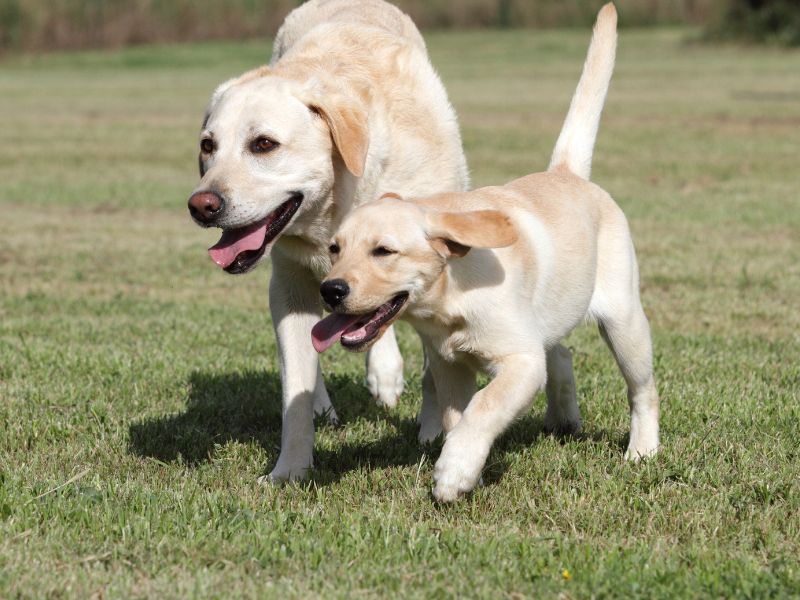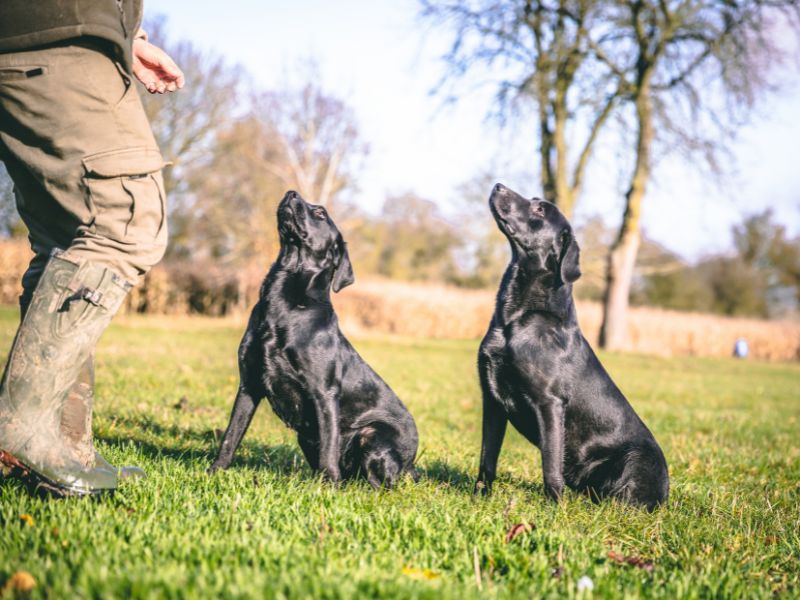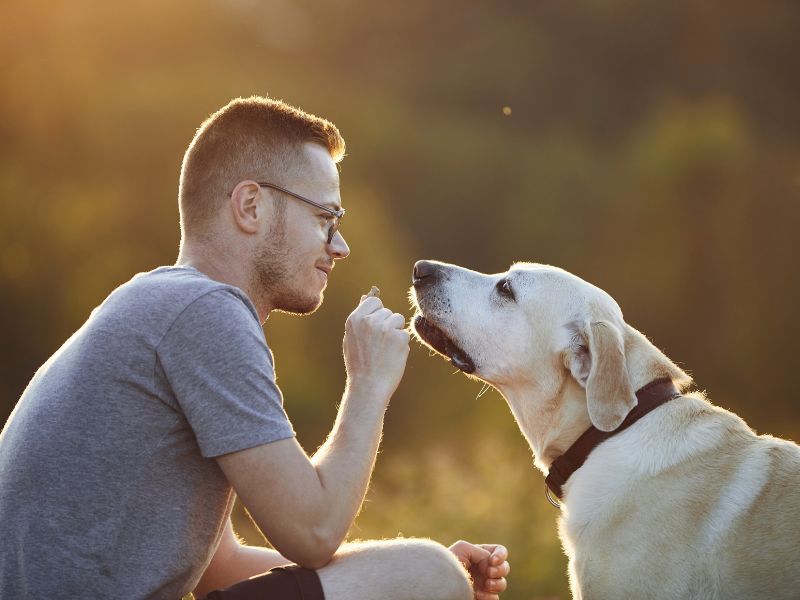Deciding the right age gap between Labradors can be a crucial decision for dog owners, as it can make all the difference in maintaining harmony and happiness in a multi-pet household. An ideal age gap allows for smooth adaptability and balanced training, ensuring the best possible experience for both dogs and their human family members.
It is generally believed that an age gap of between two and six years is suitable when considering adding another Labrador to the family. By the time a Labrador reaches the age of two, they are usually well-trained and mature. This maturity enables them to develop patience and tolerance for the playfulness and energy of a young pup joining the family.
However, it is essential to acknowledge that there is no one-size-fits-all answer when it comes to the ideal age gap between dogs. Individual personalities, energy levels, and environmental factors can significantly influence the relationship and dynamics between Labradors. Taking these variables into account allows dog owners to make the best decision for their family and their furry friends.
Should I Get Two Dogs Close Together in Age?
When considering adding a second Labrador to your family, many people wonder if it’s best to get two dogs close together in age. There are pros and cons to this decision, and it largely depends on individual circumstances and preferences.
One advantage of having two Labradors close together in age is that they can grow up together, providing each other with companionship and a playmate. This can help reduce boredom and prevent destructive behaviors. In addition, having two dogs close in age may make training easier, as they often learn from each other.
However, there are also challenges to keep in mind. Raising two puppies simultaneously can be more demanding in terms of time and energy. The cost of supplies, vet bills, and other expenses will be higher as you’ll need to accommodate the needs of both dogs. It’s essential to ensure you have the resources and capacity to train, socialize, and care for two dogs at the same time.
If you decide to take the plunge and get two Labradors close together in age, it’s important to introduce them on neutral ground to minimize territorial aggression. This may involve meeting at a quiet park or open space where both dogs can get acquainted in a relaxed environment.
The ideal age gap remains subjective, but many dog owners recommend waiting until your first dog is at least two years old and has completed its basic training before bringing home a second dog. This allows you to focus your attention on one dog’s needs at a time while also providing a more mature companion for the younger dog.
In summary, getting two Labradors close together in age has its benefits and drawbacks. As a dog owner, carefully consider your resources, time, and commitment before making this decision.
Every Family Is Different
When considering the right age gap between Labradors, it’s essential to remember that every family is unique. Each household has specific needs, preferences, and lifestyles that need to be factored into the decision-making process.
In some cases, a family might opt for a two-year age gap, as it allows the older dog to receive basic training and mature before introducing a new puppy. This approach is beneficial for many owners, as it helps establish a hierarchy and ensures that the older dog has a strong foundation before another energetic and curious pup enters the scene.
In contrast, other families might prefer a smaller age gap. For example, when an older Labrador is approaching the end of its life, some families choose to introduce a young puppy into the mix. This way, the older dog can enjoy the company of a playful companion in its final years, while the family becomes acquainted with the new addition, easing the transition when the older dog eventually passes away.
It’s crucial to consider factors such as the existing dog’s level of training, obedience, and how they may react to the introduction of a new puppy. When making a decision, families must assess their own capabilities and resources, taking into account the time and effort required to train a new pup and manage multiple energetic Labradors.
In conclusion, there is no one-size-fits-all answer to the question of the optimal age gap between Labradors. What works for one family might not work for another. Ultimately, what matters most is finding a balance that suits each individual household, keeping both the dogs and their humans happy and supported.
Should I Get Two Puppies from the Same Litter?
Getting two puppies from the same litter may seem like a good idea, as they already have a strong bond and could potentially provide companionship for one another. However, there are some important factors to consider before making this decision.
Firstly, raising two puppies from the same litter can lead to “littermate syndrome.” This occurs when the bond between the two dogs is so strong that they fail to bond properly with their human family. This can result in various behavioral issues and may cause the dogs to fight with one another as they mature into adults.
It’s also worth noting that training, socializing, and caring for two puppies is more than twice the work of caring for a single puppy. Costs such as puppy supplies, vet bills, grooming, and training classes will be higher when you have two puppies. Furthermore, the puppies may prefer to play and interact with each other, making it harder for the owner to engage with them individually.
On the positive side, having two puppies from the same litter can provide them with companionship, and each dog can be a great playmate for any children in the household. Yet, if there are two children in the home, each with a puppy, it is essential to lay ground rules for proper care, training, and attention to prevent the puppies from becoming too reliant on their sibling relationship.
In conclusion, while there are pros and cons to getting two puppies from the same litter, it is crucial to weigh the potential challenges and benefits before deciding. Developing a strong bond with individual dogs and providing them with the necessary training and socialization can be challenging, but ultimately rewarding.
What about Staggered Puppies?
When considering adding a new Labrador puppy to the family, many people wonder what the right age gap should be between their current dog and the newcomer. A staggered age gap can provide benefits to both the younger and older dogs, while also minimizing potential challenges in the household.
A general recommendation for the ideal age gap between Labradors is around two years. This allows the older dog to fully mature and complete its basic training before the arrival of the puppy. At two years of age, the older dog is more likely to be a good role model for the younger one, displaying desirable behaviors and providing guidance.
Nevertheless, there is no strict rule on the age gap, and it is ultimately up to the owner’s preferences and capabilities. Some prefer an even greater age difference, such as four years, to prevent having multiple senior dogs with decreased mobility and energy levels at the same time.
Introducing a new puppy to an older dog with a staggered age gap requires proper management and supervision. Younger puppies may have high levels of energy that older dogs might not be able to match, leading to potential issues in playtime dynamics. It is important for owners to keep an eye on their dogs during play, ensuring that the older dog is not overwhelmed and the younger one learns to respect the established boundaries.
In terms of training, the presence of an older, well-trained dog can greatly help in teaching the new puppy proper behaviors and manners. However, individual sessions should still be provided to the younger one to ensure specific training needs are met.
By providing a supportive and nurturing environment, and being aware of the dynamics between staggered-aged Labradors, owners can foster a harmonious relationship between their dogs and help them thrive together.
Size and Strength of Puppies
When considering the right age gap between Labradors, it is important to account for the size and strength differences in puppies. A five or six-month-old puppy plays in a different way from a two-month-old puppy. At six months old, a Labrador will have significantly more energy and strength than a younger pup.
Size differences can be an issue when puppies of the same age, but different breeds, play together. However, when there is an age gap too, these problems become more pronounced. For Labradors, their growth rate and weight can vary but, on average, a full-grown female Labrador Retriever should weigh between 55 and 70 pounds, standing at 21.5 to 23.5 inches tall.
During the rapid growth phase, a Labrador puppy may weigh between 25 and 40 pounds, depending on its overall size. This is the time when puppies experience their last major growth spurt before their growth starts to slow down. It is important to provide them with proper nutrition and care during this period.
When deciding on the age gap between Labradors, it is important to consider the training and maturity of the older dog. Many owners suggest waiting until the first dog is around two years old before introducing a new puppy into the family. This gives the older dog time to mature and for the owner to establish a solid training foundation.
In summary, taking into account the size and strength differences in puppies is crucial when determining the right age gap between Labradors. This ensures that both dogs can interact and play safely, without one overpowering the other.
Emotional Maturity of Puppies
When considering the right age gap between Labradors, it is crucial to understand the emotional maturity of puppies. Puppies go through different stages of development, with each stage bringing unique changes in their behavior and emotional needs.
During the early weeks of a puppy’s life, they rely heavily on their mother for care, warmth, and nourishment. Around the age of 12 weeks, puppies begin to become less fearful and explore their surroundings with increased curiosity and independence. This period, referred to as pre-adolescence, lasts until about 24 weeks and is a critical time for puppies to learn and socialize.
As puppies grow, they continue to develop emotionally. A Labrador puppy typically reaches full emotional maturity between 18 months to 2 years of age. While the rate at which a puppy matures can vary, an older, well-socialized Labrador will usually have more patience and tolerance for younger puppies, making it easier for them to interact peacefully.
When introducing a new puppy to an older Labrador, it is essential to consider their respective ages and emotional maturity levels. A two-year age gap is often recommended, as it allows the older dog to have reached maturity, providing them with stability and the ability to mentor the younger dog effectively.
However, it is also essential not to wait too long before introducing a new puppy to an older dog. Ideally, the older Labrador should be younger than six years old when the new puppy arrives. Older dogs may still be energetic and playful, but they are more likely to have the patience and knowledge to guide and tolerate the antics of a younger dog.
In conclusion, understanding the emotional maturity of puppies is a key factor in determining the ideal age gap between Labradors. A gap of around two years can provide a good balance, allowing the older dog to mentor the younger one effectively, while still enjoying their own youth and vitality.
Bonding with Two Puppies
Raising two Labrador puppies together comes with its set of challenges, particularly regarding the bonding process. While it might seem like two puppies would form an instant connection, the reality is a bit more nuanced.
Firstly, having two puppies at the same time often leads to weaker attachments between the dogs and their owner. When puppies grow up together, they can become more attached to each other than to their human caregiver. This lack of connection with the owner may lead to less effective training, as the puppies might focus more on interacting with each other than with their trainer.
In addition, introducing two Labrador puppies with a close age gap may cause some ‘top dog’ issues, as both may feel the need to establish dominance or compete with each other. This competition can result in behavioral problems and disrupt the harmony of the household.
To reduce potential issues, having an age gap between Labrador puppies is often recommended. An older puppy, around five or six months old, interacts differently with a two-month-old puppy. This slightly larger age gap can help mitigate some potential dominance issues and provide a more controlled environment for bonding and training.
However, it is essential to closely monitor interactions between the puppies, particularly if they have a significant size difference or varying energy levels. Proper supervision can help prevent injury, ensure balanced playtime, and contribute to a more peaceful household.
In summary, while raising two Labrador puppies together may seem appealing, it is crucial to consider the challenges it presents in terms of bonding and potential behavioral issues. An adequate age gap, along with attentive training and supervision, can be key factors in creating a harmonious environment and fostering strong connections with both puppies.
Get Pippa’s Training Tips!
When it comes to training Labradors, Pippa is a well-regarded figure in the community. She offers valuable tips and advice based on her personal experiences and research. Let’s dive into some of her best tips for managing age gaps between Labradors in the same family.
First, Pippa suggests that it’s important to consider the age gap between your dogs when they’re still young puppies. A five or six-month-old puppy will interact quite differently than a two-month-old one, and their size differences can become more apparent as they grow older. When there is an age gap between puppies, it can exacerbate the potential for issues.
To prevent potential ‘top dog’ issues, Pippa recommends introducing activities that promote equal participation. One of these activities is leash training to reduce pulling. For this, Pippa suggests using the “turn” method:
- Begin walking in one direction with your dog.
- As soon as they pull, stop walking, and get their attention.
- Turn around and face the direction you came from.
- Encourage your dog to come to your side and reward them with a treat.
This method can not only help in training them individually but also in teaching both dogs to walk together and maintain a comfortable pace.
Labrador retrievers are known for being great students, making it easier to house-train them, even when dealing with different ages. Keep a consistent schedule and rotate activities like crate training, socialization, and obedience training with both younger and older dogs to ensure proper growth and development.
Creating a healthy age gap between Labradors in the same family is a matter of setting the right pace, maintaining effective training, and fostering a strong bond between the dogs. By following Pippa’s training tips and customizing them to suit your specific needs, you can ensure a harmonious relationship between your Labradors, regardless of their age difference.
House-Training Two Puppies
Training two puppies at once may seem like a daunting challenge, but with the right approach, it can be a rewarding experience. When house-training two Labradors, it’s important to consider the age gap between them, as this can greatly impact their training process.
Ideally, you should aim for an age gap of at least five to six months between the two puppies, as this can help mitigate any potential dominance issues and reduce the risk of “littermate syndrome.” Pairing puppies closer in age can lead to increased competition, behavioral issues, and hinder their individual development.
Start by establishing a consistent routine for both puppies that includes regular potty breaks and separate feeding times. Providing designated play spaces and sleeping areas for each puppy is crucial to cultivate a sense of independence.
When it comes to house-training, consistency and patience are key. Both puppies should be taken outside at specific times, such as after meals, before bedtime, and first thing in the morning. Praise and reward them individually for their successes, as this will reinforce positive behaviors.
Training the puppies separately is also essential for their individual growth and development. This can be achieved by attending training classes separately, or working with one puppy at a time at home while the other is in a separate room with another family member. This approach promotes focused learning and ensures both puppies receive the required attention.
Remember to provide each puppy with:
- Separate crates for sleeping and personal space
- Individual potty-training and command training sessions
- One-on-one attention and bonding with their human family members
- Distinct toys and play areas
By considering the appropriate age gap, setting a consistent routine, and working with each puppy individually, you can successfully house-train two Labradors and create a harmonious living environment.
Two Puppies Will Need Two Crates
When planning to bring two Labrador puppies into your home, it’s important to understand that each will require their own crate. Providing individual crates not only ensures a safe space for each pup but also aids in the critical training process.
Crate training is an effective tool for promoting proper behavior and establishing boundaries. Each Labrador will benefit from having their crate, where they can feel secure and comfortable. Introducing two puppies to the family simultaneously may increase the household’s overall workload, so ensuring they each have their own crate will help manage their needs.
Additionally, most Labradors don’t outgrow the chewing phase until they are well over a year old. By providing separate crates, you’re reducing the chances of your puppies destroying belongings or harming themselves by chewing on inappropriate items. In turn, this helps owners maintain a clean, orderly, and safe environment.
When it comes to socialization, separate crates are also essential for preventing littermate syndrome, which occurs when two puppies are raised together beyond the recommended 10-12 weeks of age. Littermate syndrome can lead to various behavioral issues stemming from poor socialization skills developed during a puppy’s crucial first six months. To properly socialize your Labradors, make sure they have individual opportunities for training, playing, and bonding with you, and are not reliant only on each other for all of their social needs.
Remember that a key to successfully raising two Labrador puppies is investing in proper crate training and providing individual spaces for them to grow and learn. This will help ensure their wellbeing, promote proper behavior and development, and make the experience of welcoming two puppies into your home a positive and rewarding one.
Obedience Training Two Puppies
Training two puppies, especially of the same age, can be quite challenging. It is important to create a healthy environment for each puppy’s individual growth and development. One common issue that may arise is “littermate syndrome,” where the puppies become more attached to each other than to their human family members. This can lead to difficulties in training as they may be more focused on each other than their trainer.
To effectively train two puppies at once, it is essential to provide separate training sessions focused on each puppy individually. This allows them to become comfortable with one-on-one interactions and helps build a strong bond between the puppy and its trainer. During individual training sessions, concentrate on teaching basic obedience commands such as sit, stay, and come. Training should be short and fun, utilizing positive reinforcement with treats or praise.
In addition to individual training, supervised group training sessions can be beneficial. These sessions should be structured, and each puppy should be given an opportunity to perform and receive feedback. Such interactions can promote healthy socialization between the puppies and build their confidence in understanding commands with distractions present.
While training two puppies has its challenges, it is possible to achieve success when specific factors are considered, including their training needs and content of the exercises. The ideal age gap between Labradors usually is around two years, which allows your first dog to be properly trained and matured before introducing a new puppy into the family. This helps you to focus on each dog’s individual needs, creating a harmonious and respectful relationship within your furry family.
The Right Age Gap Between Labradors
When considering the right age gap between Labrador dogs, it is essential to take into account the level of maturity, energy, and training of the older dog. Ideally, the age gap between two Labradors should be anywhere between two and six years.
By the time the older dog reaches two years of age, they should be well-trained and have developed the patience and tolerance needed to handle a young and energetic puppy. This age difference allows the older dog time to reach maturity and acquire the necessary skills to interact with a new, younger addition to the family.
It is important to consider the difference in play styles and energy levels between dogs of different ages. For example, a five or six-month-old puppy will play differently from a two-month-old puppy, and their energy reserves and strength will be far more significant. The size difference can also be an issue when puppies of the same age but different breeds play together. However, when there is an age gap as well, the problems can be exacerbated.
That being said, age does not always determine the compatibility of dogs. Some Labradors will be more comfortable with a greater age difference, while others may not mind having a smaller gap. It is crucial to observe the dogs’ behavior, temperament, and energy levels when introducing a new puppy to the family.
In conclusion, while an age gap of two to six years is a good starting point when considering the right age difference between Labradors, individual characteristics and compatibility should also be taken into account to ensure a harmonious relationship between the dogs.
Enjoying Your Time with One Puppy
It’s essential for new Labrador owners to relish their time with their first puppy before considering adding a second one to the family. Spending quality time with a single puppy can help strengthen the bond between owner and pet, creating a solid foundation for future additions.
During the first twelve months, a Labrador puppy goes through various developmental stages, including learning basic training, socialization, and meshing with the family dynamics. Focusing on one puppy at a time allows the owner to give them the appropriate attention for their needs, ensuring a well-adjusted and happy dog.
Moreover, it’s vital to acknowledge that puppies of different age groups play differently. A five or six-month-old Labrador has a different play style and energy level compared to a two-month-old one. A significant age gap might create difficulties when introducing a new puppy, as the older dog’s strength and energy levels may overwhelm the younger one.
When the first Labrador reaches at least two years of age, they typically have completed their basic training and matured. This maturation is an ideal time for owners to consider introducing a new furry family member, as the older dog will be more comfortable sharing their space and adjusting to a new playmate.
By ensuring the first Labrador is well-trained, happy, and comfortable in its environment, the introduction of a second pup becomes a smoother experience for both owner and pet. So, taking time to appreciate and care for one puppy significantly impacts the wellbeing of both dogs when the time comes to expand the canine family.
How about You?
When considering the right age gap between Labradors, it’s essential to think about individual circumstances. Every family and dog is unique, so what works for one household may not be ideal for another.
First and foremost, think about the energy levels and temperament of the existing Labrador in your home. If your current dog is active and well-adjusted, introducing a new puppy when the older dog is around two years old can be a good option. This age gap allows the older dog to offer guidance and help with training, without being overwhelmed by the younger dog’s energy.
However, if your older Labrador tends to be more laid-back or less social, waiting until they are between three to four years old before bringing home a new puppy might be more suitable. This will ensure the older dog has had sufficient time to mature and develop a stable personality, which can be beneficial when integrating a new family member.
Additionally, it’s crucial to assess the family’s lifestyle and available resources before making a decision on the right age gap between Labradors. Having two dogs close in age can be demanding in terms of time, training, and financial expenses. Waiting until the first dog is fully grown and trained can help ease the transition and ensure that both dogs get the attention and care they need.
Ultimately, the right age gap between Labradors will depend on the specific needs and circumstances of both the dogs and the family. By carefully considering all factors and being realistic about the commitment involved, a harmonious living environment can be achieved for all members, both furry and human.
More Information on Puppies

When considering the right age gap between Labradors, it’s important to take into account their development and play styles. Puppies go through different stages of growth, and understanding these stages can help determine the best age gap for your dogs.
A five or six-month-old Labrador puppy plays differently from a two-month-old puppy. At six months old, a Lab’s reserves of energy and strength will be far greater than their younger counterparts. Size difference alone can be an issue when puppies of the same breed, but different ages, play together. An age gap can exacerbate these problems.
In some cases, a close age gap between dogs can cause ‘top dog’ issues. It depends on the individual Labradors and their personalities. It’s essential to evaluate each dog’s temperament and consider how the dynamics may change with the introduction of a new puppy.
Labradors generally reach sexual maturity between 6 and 9 months, physical maturity between 11 and 18 months, and mental maturity around 2 years old. Remember, individual Labs will mature at different rates, so these timeframes can vary.
When determining the best age gap between your Labradors, consider the following:
- Their play styles and energy levels
- Potential ‘top dog’ issues
- The age at which Labs reach different maturity stages
Selecting the right age gap is an emotional decision as well. Many dog owners prefer a gap that minimizes the likelihood of both dogs passing away due to old age at the same time. This helps to avoid the heartbreak of losing two companions in quick succession.
In conclusion, it’s essential to carefully consider the age gap between Labradors, taking into account developmental stages, play styles, and individual dogs’ temperaments. A well-thought-out decision will lead to a harmonious relationship between your canine companions.














